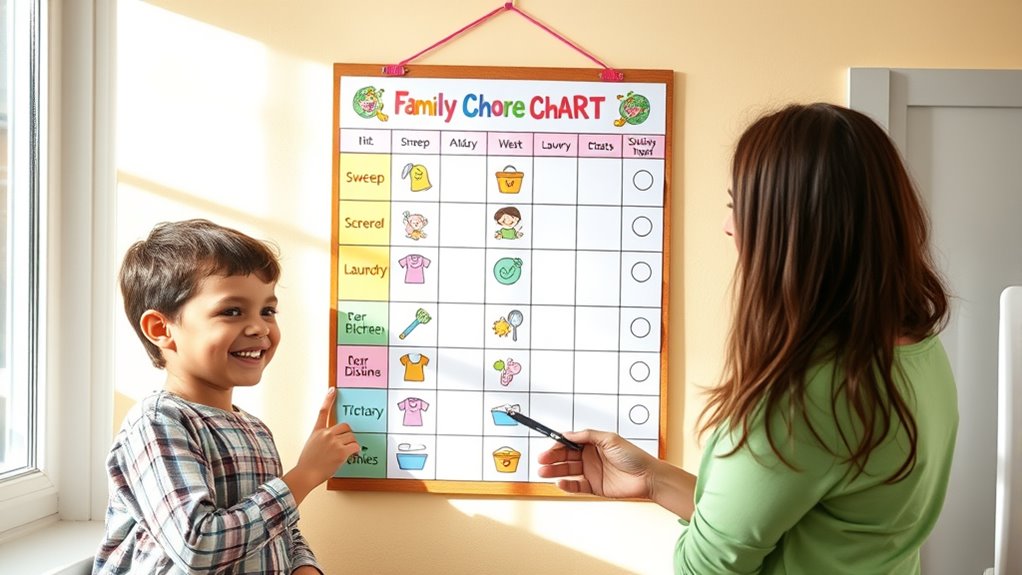Creating an effective family chore chart starts with evaluating your family’s routines and setting clear, manageable goals based on everyone’s age and abilities. Design a colorful, easy-to-understand visual system with icons and color-coding. Assign tasks fairly, rotate chores, and celebrate successes to foster responsibility and teamwork. Keep the chart flexible to adapt to changes or emergencies. For more tips on maintaining motivation and building a positive environment, explore further guidance here.
Key Takeaways
- Assess family routines and set clear, manageable goals tailored to each member’s age and skills.
- Design a visual, colorful, and simple chore chart using icons and color-coding for clarity.
- Rotate chores fairly, involve children, and recognize efforts to promote shared responsibility and teamwork.
- Incorporate age-appropriate incentives, review, and adjust chores regularly to keep everyone motivated and tasks relevant.
- Maintain flexibility by updating the chart, accommodating emergencies, and fostering a positive, collaborative family environment.
Assessing Your Family’s Needs and Setting Clear Goals
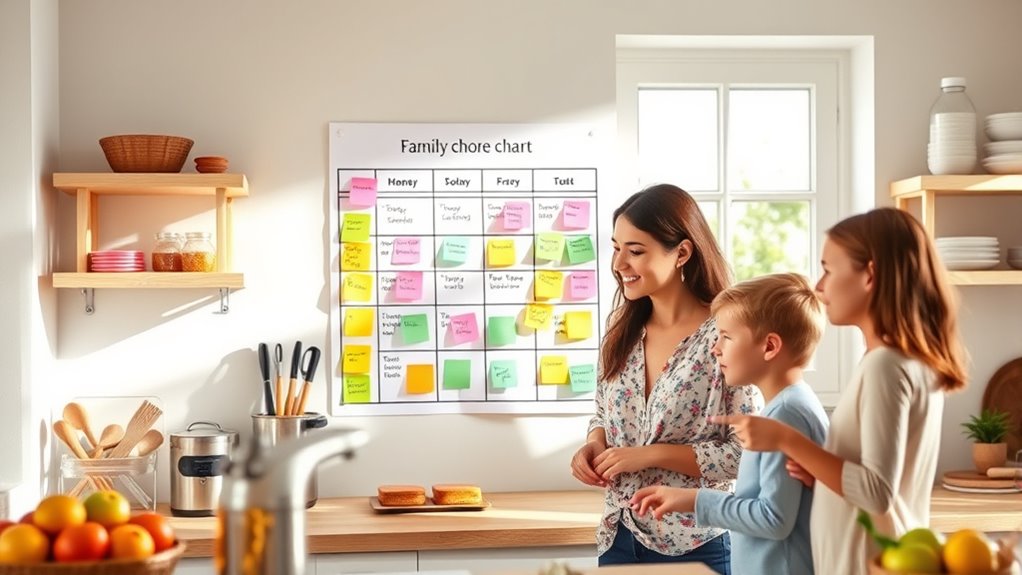
To create effective family chore charts, you first need to evaluate your family’s specific needs. Clear communication helps you understand everyone’s daily routines and responsibilities. Talk openly with your family members about what chores they can handle and what tasks need attention. This way, you identify busy periods and avoid overloading anyone. Setting clear goals ensures chores are manageable and fair, fostering cooperation. Consider each person’s age, skills, and schedule to tailor chores accordingly. Establishing priorities helps you focus on essential tasks first, making daily routines smoother. When everyone understands their role and expectations, family communication improves, and chores become part of your daily life rather than a source of conflict. This assessment creates a solid foundation for an effective chore system.
Designing a Visual and User-Friendly Chore Chart
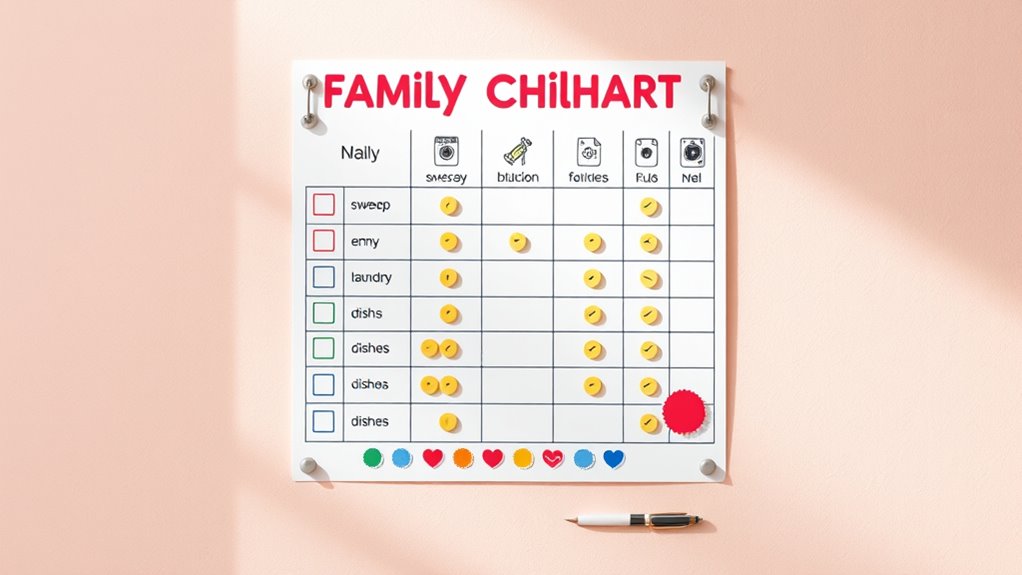
To make your chore chart easy to use, focus on creating a clear visual hierarchy so tasks stand out. Keep the design simple and colorful to grab attention and make it enjoyable for everyone. A well-organized chart helps your family stay on track without confusion. Incorporating visual cues such as icons or color-coding can further enhance clarity and make the chart more engaging.
Clear Visual Hierarchy
Creating a clear visual hierarchy is essential for making a chore chart easy to understand at a glance. It guides your family’s eyes to prioritize tasks effectively. Use size, color, and placement to distinguish between high-priority and less urgent chores. For example, highlight essential tasks with bold fonts or bright colors, and place them at the top or in prominent positions. Group related chores together to reinforce task prioritization. Consistency is key—use the same symbols, fonts, and colors throughout the chart. This helps everyone quickly identify what needs attention first. A well-organized visual hierarchy reduces confusion, saves time, and encourages accountability, making the chore chart a practical tool for managing household responsibilities efficiently. Incorporating visual cues can further enhance understanding and adherence to the chore schedule.
Simple and Colorful Design
A simple and colorful design makes your chore chart inviting and easy to navigate. Use colorful illustrations to highlight different chores and add visual interest, making the chart more engaging for everyone. Bright colors help distinguish tasks and assign responsibilities clearly, reducing confusion. Choose playful fonts that are easy to read but also fun, capturing everyone’s attention. Keep the layout straightforward, with enough space for signatures or checkmarks to track progress. Avoid clutter by limiting the number of colors and design elements. The goal is to create a chart that’s visually appealing, quick to understand, and motivating for all family members. A well-designed, vibrant chore chart encourages participation and makes chore management feel less like a chore itself. Incorporating visual hierarchy can help guide the eye and improve overall clarity, making the chart even more user-friendly.
Assigning Tasks Fairly and Encouraging Responsibility

Assigning chores fairly guarantees that everyone in the family shares the workload and feels responsible. When you involve kids in meal planning and chore delegation, they understand their roles and develop accountability. To guarantee fairness, consider rotating tasks regularly so no one feels stuck with the same chores. Talk openly about expectations and listen to your family’s input—this encourages cooperation. Set clear boundaries for responsibilities, making sure each person’s tasks match their age and abilities. Recognize effort, not just completion, to foster a sense of accomplishment. By assigning chores thoughtfully and involving everyone in decision-making, you promote responsibility and teamwork. This approach helps your family see chores as shared duties, not burdens, and encourages consistent participation. Incorporating a family chore chart can also enhance organization and ensure transparency in task distribution.
Incorporating Incentives and Rewards for Motivation
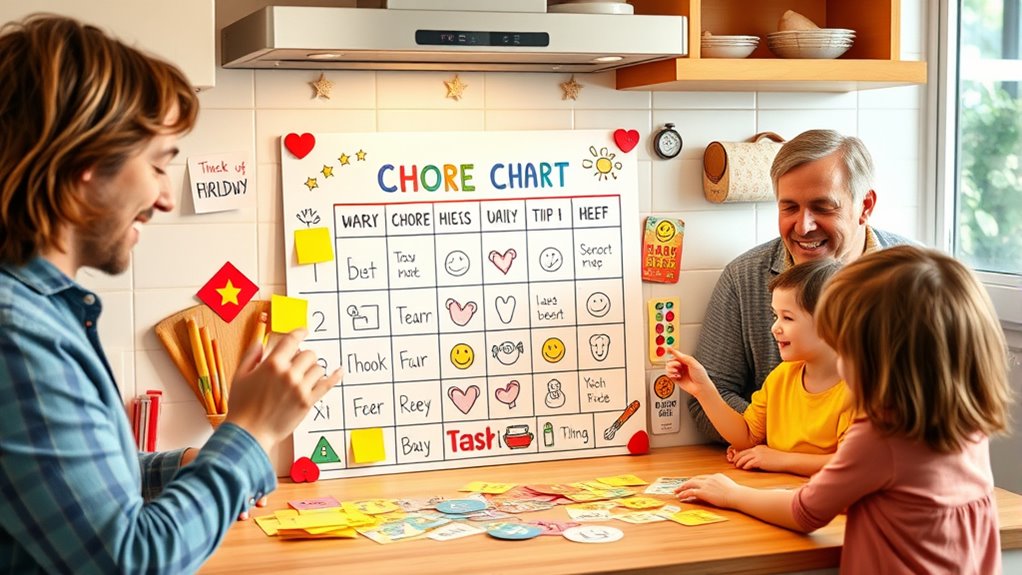
Using the right incentives can boost your family’s motivation to complete chores. Consider effective reward types that resonate with each family member, and choose the right timing to keep enthusiasm high. When you match rewards with effort, chores become a more positive and engaging experience for everyone. Additionally, planning chores around support hours and scheduling can help ensure that everyone stays on track and that rewards are timely and meaningful.
Effective Reward Types
What types of rewards truly motivate children to complete their chores? Generally, extrinsic motivation, like praise or tangible prizes, can encourage immediate effort. However, intrinsic rewards—such as a sense of accomplishment or pride—often foster lasting motivation. To be effective, a mix of both works best. For example, offering a small reward can jump-start the habit, while emphasizing personal growth and responsibility nurtures internal satisfaction. Kids respond well to recognition, extra privileges, or small treats, but they also thrive when they see how chores contribute to family well-being. Keep in mind, rewards should be meaningful and appropriate to avoid undermining intrinsic motivation. Striking this balance helps children develop a positive attitude toward chores and builds internal motivation over time. Incorporating positive reinforcement techniques can further enhance motivation and reinforce good habits.
Timing Incentive Rewards
Timing plays a crucial role in maximizing the effectiveness of incentive rewards. Using well-planned timing strategies ensures rewards motivate your family members consistently. For example, offering immediate reinforcement after chores helps reinforce positive behavior and keeps motivation high. Conversely, delaying rewards can weaken the connection between effort and payoff. To maintain reward consistency, set clear expectations about when rewards will be given, whether daily or weekly. Consistent timing helps family members anticipate and understand the value of their efforts. Adjust your timing strategies based on individual preferences, guaranteeing rewards feel timely and meaningful. Additionally, understanding personality traits can help tailor the timing of rewards to suit each family member’s unique motivation style. By focusing on proper timing, you create a motivating environment where chores become a rewarding experience, encouraging ongoing participation and fostering good habits.
Maintaining Flexibility and Adjusting the Chart Over Time
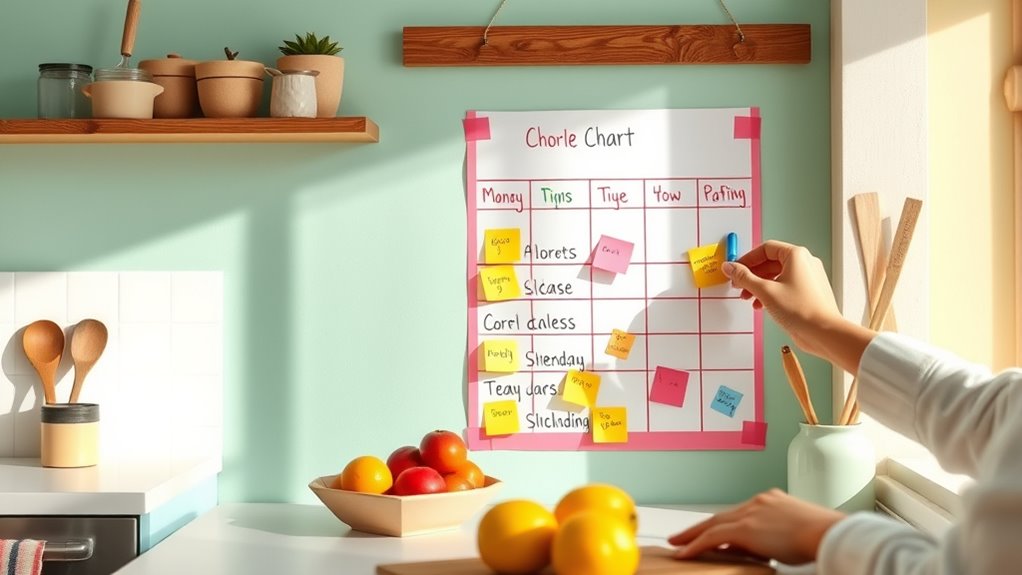
As your family’s routines evolve, it’s important to stay flexible and willing to modify the chore chart accordingly. Life changes, seasons shift, and emergency plans may require quick updates. Regularly reviewing the chart helps ensure chores stay relevant and manageable. For example, during seasonal adjustments, you might assign outdoor tasks in warmer months and indoor chores during winter. Flexibility also means accommodating unexpected events, like illness or emergencies, by redistributing responsibilities temporarily. Keep a simple system for updating chores:
| Situation | Adjustment Needed | Responsible Person |
|---|---|---|
| Seasonal shifts | Swap outdoor and indoor chores | Family meeting |
| Emergency or illness | Short-term redistribution | Parent or caregiver |
| Routine review | Adjust chores based on progress | Family collectively |
This approach keeps chores fair and manageable, adapting smoothly over time.
Fostering Teamwork and Celebrating Successes

Fostering teamwork and celebrating successes encourage a positive family environment and motivate everyone to stay engaged with their chores. When you emphasize parental involvement, kids see that their efforts matter and feel supported. Encourage peer collaboration by assigning group tasks that require cooperation, making chores more social and less of a burden. Recognize achievements openly, whether through praise or small rewards, to reinforce a sense of accomplishment. Celebrating milestones, like completing a week of chores, boosts morale and builds a team spirit. By highlighting how each person’s contribution helps the whole family, you create a culture of shared responsibility. Understanding the importance of collaboration in chores can further enhance teamwork and cooperation among family members. This approach not only motivates children but also teaches valuable life skills like collaboration, accountability, and celebrating collective successes.
Frequently Asked Questions
How Can I Involve Children in Creating the Chore Chart?
You can involve children in creating the chore chart by making it a fun, collaborative process. Let them participate in chore chart design, choosing tasks they enjoy or feel capable of doing, which helps motivate kids. Encourage their input on layout and visuals to make it appealing. This involvement gives kids a sense of ownership, boosting motivation and making chores feel less like a burden and more like a team effort.
What Are Signs My Chore Chart Isn’T Effective?
If your chore chart isn’t working, watch for waning motivation issues or unclear expectations. You might notice kids skipping tasks, procrastinating, or showing little enthusiasm. When chores seem confusing or unfair, it dampens their drive. To fix this, clarify responsibilities, keep tasks consistent, and celebrate small successes. If chores become chaotic or commitments crumble, it’s time to tweak your chart, making chores clear, consistent, and compelling to boost motivation and clarity.
How Do I Handle Non-Compliance Respectfully?
When handling non-compliance, you should practice respectful communication and focus on conflict resolution. Talk calmly with the person involved, listen to their perspective, and express your concerns without blame. Set clear expectations and collaborate on solutions that work for everyone. By staying respectful and open-minded, you encourage cooperation and build trust, making it easier to resolve conflicts and make sure chores get done without unnecessary tension.
What Are Age-Appropriate Chores for Different Children?
You should assign age-appropriate tasks based on your child’s development and chore difficulty. For young children, simple tasks like picking up toys or setting the table work well. As they grow, introduce more challenging chores like sweeping or doing laundry. Always consider their abilities and gradually increase chore difficulty to build responsibility. This approach helps your kids stay engaged and proud of their contributions around the house.
How Can I Balance Chores With Other Family Activities?
Think of balancing chores and family activities like conducting a symphony. You can keep everyone motivated with rewards and chore chart customization, making tasks feel rewarding rather than burdensome. Schedule chores around shared activities, and involve everyone in planning. This way, chores become part of the rhythm, not an interruption. Regular check-ins help keep harmony, ensuring chores and family fun stay perfectly synchronized.
Conclusion
By crafting a chore chart that’s clear and inviting, you turn daily tasks into a team adventure rather than a burden. Think of it as planting seeds of responsibility and watering them with encouragement and rewards. As your family grows and changes, let your chart evolve like a trusty compass guiding you through new responsibilities. Together, you’ll build a garden of teamwork and pride, where everyone blooms and success becomes a shared harvest.
